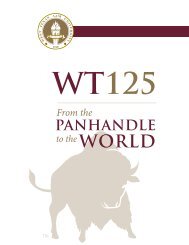The Economic Value of WTAMU Main Report
This report assesses the impact of West Texas A&M University (WTAMU) on the regional economy and the benefits generated by the university for students, taxpayers, and society. The results of this study show that WTAMU creates a positive net impact on the regional economy and generates a positive return on investment for students, taxpayers, and society.
This report assesses the impact of West Texas A&M University (WTAMU) on the regional economy and the benefits generated by the university for students, taxpayers, and society. The results of this study show that WTAMU creates a positive net impact on the regional economy and generates a positive return on investment for students, taxpayers, and society.
You also want an ePaper? Increase the reach of your titles
YUMPU automatically turns print PDFs into web optimized ePapers that Google loves.
Together, labor and non-labor income comprise the region’s total income,<br />
which can also be considered as the region’s gross regional product (GRP).<br />
As shown in Table 1.3, the total income, or GRP, <strong>of</strong> the Texas Panhandle is<br />
approximately $25 billion, equal to the sum <strong>of</strong> labor income ($14 billion) and<br />
non-labor income ($11 billion). In Chapter 2, we use the total added income as<br />
the measure <strong>of</strong> the relative impacts <strong>of</strong> the university on the regional economy.<br />
Figure 1.4 provides the breakdown <strong>of</strong> jobs by industry in the Texas Panhandle.<br />
Among the region’s non-government industry sectors, the Retail Trade sector<br />
is the largest employer, supporting 26,406 jobs or 9.6% <strong>of</strong> total employment<br />
in the region. <strong>The</strong> second largest employer is the Manufacturing sector, supporting<br />
25,668 jobs or 9.3% <strong>of</strong> the region’s total employment. Altogether, the<br />
region supports 275,578 jobs. 6<br />
FIGURE 1.4: JOBS BY MAJOR INDUSTRY SECTOR IN THE TEXAS PANHANDLE, 2018*<br />
0 5,000 10,000 15,000 20,000 25,000<br />
30,000<br />
Retail Trade<br />
Manufacturing<br />
Agriculture, Forestry, Fishing & Hunting<br />
Health Care & Social Assistance<br />
Government, Education<br />
Accommodation & Food Services<br />
Government, Non-Education<br />
Finance & Insurance<br />
Construction<br />
Mining, Quarrying, & Oil and Gas Extraction<br />
Other Services (except Public Administration)<br />
Transportation & Warehousing<br />
Administrative & Waste Services<br />
Real Estate & Rental & Leasing<br />
Wholesale Trade<br />
Pr<strong>of</strong>essional & Technical Services<br />
Arts, Entertainment, & Recreation<br />
Information<br />
Utilities<br />
Educational Services<br />
Management <strong>of</strong> Companies & Enterprises<br />
100+100+100+100+100+100+100+100+100+100+100+100+100+100+100+100+100+100+100+100+100 100+97+89+82+74+69+68+67+64+61+59+37+35+34+34+33+12+8+7+6+5<br />
* Data reflect the most recent year for which data are available. Emsi data are updated quarterly.<br />
Source: Emsi employment data.<br />
6 Job numbers reflect Emsi’s complete employment data, which includes the following four job classes: 1) employees<br />
who are counted in the Bureau <strong>of</strong> Labor Statistics’ Quarterly Census <strong>of</strong> Employment and Wages (QCEW),<br />
2) employees who are not covered by the federal or state unemployment insurance (UI) system and are thus<br />
excluded from QCEW, 3) self-employed workers, and 4) extended proprietors.<br />
Chapter 1: Pr<strong>of</strong>ile <strong>of</strong> West Texas A&M University and the Economy 18





